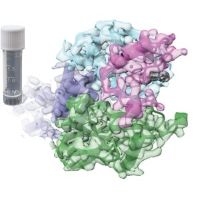Specification
| Description | Recombinant protein from the full-length sequence of Homo sapiens ubiquilin 4 (UBQLN4), transcript variant 1 (NM_020131). |
| Organism | Homo sapiens (Human) |
| Expression Host | Human Cells |
| Tag Info | His or DYKDDDDK. Please contact us if you need further information or require specific designed tag. |
| Purity | Greater than 90% by SDS-PAGE gel |
| Uniprot ID | Q9NRR5 |
| Entry Name | UBQL4_HUMAN |
| Gene Names | UBQLN4 C1orf6 CIP75 UBIN |
| Alternative Gene Names | C1orf6 CIP75 UBIN |
| Alternative Protein Names | Ubiquilin-4 (Ataxin-1 interacting ubiquitin-like protein) (A1Up) (Ataxin-1 ubiquitin-like-interacting protein A1U) (Connexin43-interacting protein of 75 kDa) (CIP75) |
| Application | Antigens, Western, ELISA and other in vitro binding or in vivo functional assays, and protein-protein interaction studies; For research & development use only! |
| Buffer | Purified protein formulated in a sterile solution of PBS buffer, pH7.2, without any preservatives |
| Endotoxin | Endotoxin level is < 0.1 ng/µg of protein (<1EU /µg) |
| Length | 601 |
| Molecular Weight(Da) | 63853 |
| Protein Sequence | (The sequence of expressed protein may have some variation from the sequence shown below. Please contact us for the exact sequence.) MAEPSGAETRPPIRVTVKTPKDKEEIVICDRASVKEFKEEISRRFKAQQDQLVLIFAGKILKDGDTLNQHGIKDGLTVHLVIKTPQKAQDPAAATASSPSTPDPASAPSTTPASPATPAQPSTSGSASSDAGSGSRRSSGGGPSPGAGEGSPSATASILSGFGGILGLGSLGLGSANFMELQQQMQRQLMSNPEMLSQIMENPLVQDMMSNPDLMRHMIMANPQMQQLMERNPEISHMLNNPELMRQTMELARNPAMMQEMMRNQDRALSNLESIPGGYNALRRMYTDIQEPMFSAAREQFGNNPFSSLAGNSDSSSSQPLRTENREPLPNPWSPSPPTSQAPGSGGEGTGGSGTSQVHPTVSNPFGINAASLGSGMFNSPEMQALLQQISENPQLMQNVISAPYMRSMMQTLAQNPDFAAQMMVNVPLFAGNPQLQEQLRLQLPVFLQQMQNPESLSILTNPRAMQALLQIQQGLQTLQTEAPGLVPSLGSFGISRTPAPSAGSNAGSTPEAPTSSPATPATSSPTGASSAQQQLMQQMIQLLAGSGNSQVQTPEVRFQQQLEQLNSMGFINREANLQALIATGGDINAAIERLLGSQLS |
Background
| Function | FUNCTION: Regulator of protein degradation that mediates the proteasomal targeting of misfolded, mislocalized or accumulated proteins (PubMed:15280365, PubMed:27113755, PubMed:29666234, PubMed:30612738). Acts by binding polyubiquitin chains of target proteins via its UBA domain and by interacting with subunits of the proteasome via its ubiquitin-like domain (PubMed:15280365, PubMed:27113755, PubMed:30612738). Key regulator of DNA repair that represses homologous recombination repair: in response to DNA damage, recruited to sites of DNA damage following phosphorylation by ATM and acts by binding and removing ubiquitinated MRE11 from damaged chromatin, leading to MRE11 degradation by the proteasome (PubMed:30612738). MRE11 degradation prevents homologous recombination repair, redirecting double-strand break repair toward non-homologous end joining (NHEJ) (PubMed:30612738). Specifically recognizes and binds mislocalized transmembrane-containing proteins and targets them to proteasomal degradation (PubMed:27113755). Collaborates with DESI1/POST in the export of ubiquitinated proteins from the nucleus to the cytoplasm (PubMed:29666234). Also plays a role in the regulation of the proteasomal degradation of non-ubiquitinated GJA1 (By similarity). Acts as an adapter protein that recruits UBQLN1 to the autophagy machinery (PubMed:23459205). Mediates the association of UBQLN1 with autophagosomes and the autophagy-related protein LC3 (MAP1LC3A/B/C) and may assist in the maturation of autophagosomes to autolysosomes by mediating autophagosome-lysosome fusion (PubMed:23459205). {ECO:0000250|UniProtKB:Q99NB8, ECO:0000269|PubMed:15280365, ECO:0000269|PubMed:23459205, ECO:0000269|PubMed:27113755, ECO:0000269|PubMed:29666234, ECO:0000269|PubMed:30612738}. |
| Pathway | |
| Protein Families | |
| Tissue Specificity | Highly expressed in pancreas, kidney, skeletal muscle, heart and throughout the brain, and at lower levels in placenta, lung and liver. {ECO:0000269|PubMed:11001934}. |
QC Data
| Note | Please contact us for QC Data |
| Product Image (Reference Only) |  |

